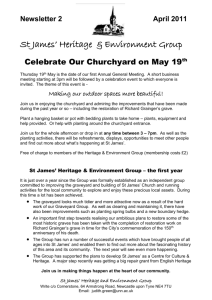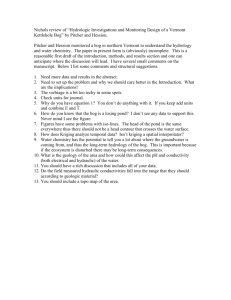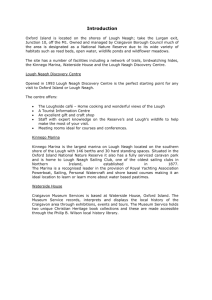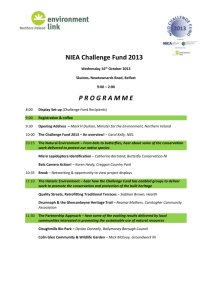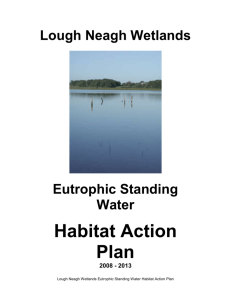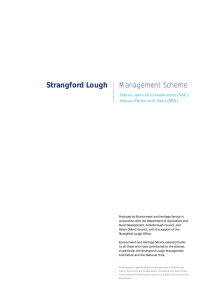Places to Visit Boyounagh Graveyard This graveyard is situated in
advertisement
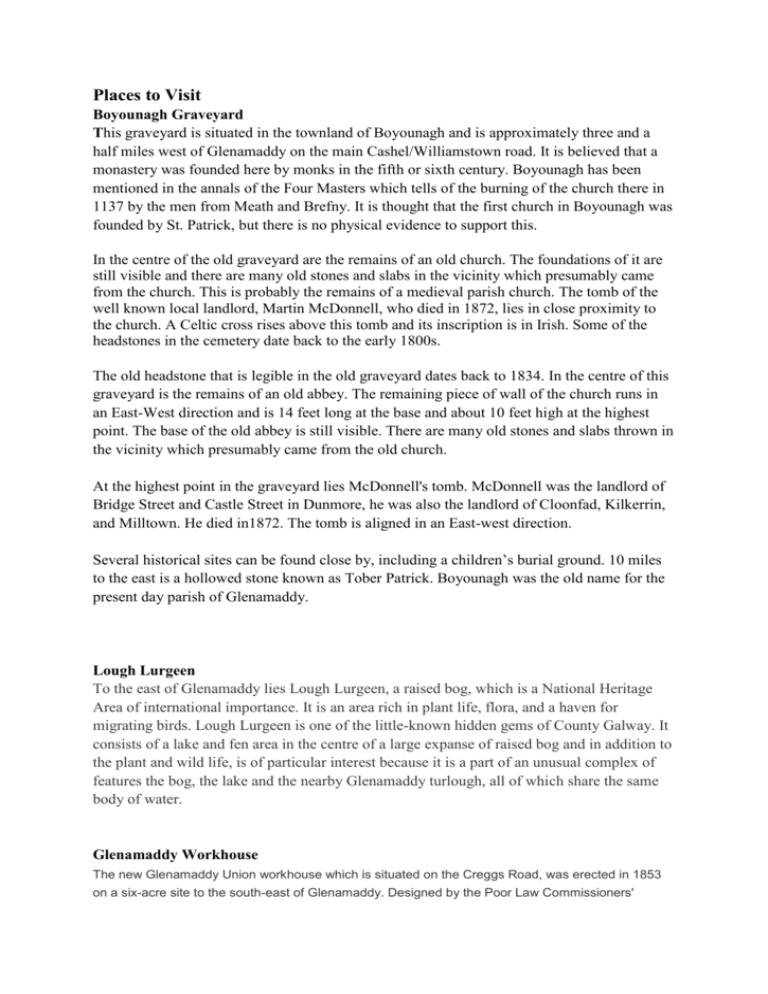
Places to Visit Boyounagh Graveyard This graveyard is situated in the townland of Boyounagh and is approximately three and a half miles west of Glenamaddy on the main Cashel/Williamstown road. It is believed that a monastery was founded here by monks in the fifth or sixth century. Boyounagh has been mentioned in the annals of the Four Masters which tells of the burning of the church there in 1137 by the men from Meath and Brefny. It is thought that the first church in Boyounagh was founded by St. Patrick, but there is no physical evidence to support this. In the centre of the old graveyard are the remains of an old church. The foundations of it are still visible and there are many old stones and slabs in the vicinity which presumably came from the church. This is probably the remains of a medieval parish church. The tomb of the well known local landlord, Martin McDonnell, who died in 1872, lies in close proximity to the church. A Celtic cross rises above this tomb and its inscription is in Irish. Some of the headstones in the cemetery date back to the early 1800s. The old headstone that is legible in the old graveyard dates back to 1834. In the centre of this graveyard is the remains of an old abbey. The remaining piece of wall of the church runs in an East-West direction and is 14 feet long at the base and about 10 feet high at the highest point. The base of the old abbey is still visible. There are many old stones and slabs thrown in the vicinity which presumably came from the old church. At the highest point in the graveyard lies McDonnell's tomb. McDonnell was the landlord of Bridge Street and Castle Street in Dunmore, he was also the landlord of Cloonfad, Kilkerrin, and Milltown. He died in1872. The tomb is aligned in an East-west direction. Several historical sites can be found close by, including a children’s burial ground. 10 miles to the east is a hollowed stone known as Tober Patrick. Boyounagh was the old name for the present day parish of Glenamaddy. Lough Lurgeen To the east of Glenamaddy lies Lough Lurgeen, a raised bog, which is a National Heritage Area of international importance. It is an area rich in plant life, flora, and a haven for migrating birds. Lough Lurgeen is one of the little-known hidden gems of County Galway. It consists of a lake and fen area in the centre of a large expanse of raised bog and in addition to the plant and wild life, is of particular interest because it is a part of an unusual complex of features the bog, the lake and the nearby Glenamaddy turlough, all of which share the same body of water. Glenamaddy Workhouse The new Glenamaddy Union workhouse which is situated on the Creggs Road, was erected in 1853 on a six-acre site to the south-east of Glenamaddy. Designed by the Poor Law Commissioners' architect George Wilkinson, the building was based on one of his standard plans to accommodate 500 inmates. Its construction cost £5,250 plus £995 for fittings etc. From around 1900, nursing at the workhouse infirmary was under the charge of the Bon Secours Sisters. The main building was burnt down in 1921. The hospital section later served as an orphanage and as the district dispensary. The remains of buildings now lie derelict. A memorial stands at the roadside. Lough Key Forest Park Rockingham Boyle Co Roscommon www.loughkey.ie Numerous walks and trails through Lough Key Forest Park enable exploration of the Park's unique, natural and historical features from its 19th century parkland with majestic trees, follies, bridges and canals to the native woodlands, Bog Garden and forests. A wealth of historical and archaeological points of interest can be found throughout the Park including ringforts, a souterrain, Fishing Pavilion, Fairy Bridge, Wishing Chair, Ice House, Stables and Estate Chapel. With its diverse habitats the Park is home to many species of wildlife. Wild flowers in the Park include bluebell, wild garlic, wood anemone, ragged robin, summer snowflake, wood sorrel, primrose, yellow iris and meadow sweet. Mammals present include the fallow deer, fox, hare, rabbit, red squirrel and stoat, while the bat, otter and badger are mainly active at night. Birds to be seen along the lakeshore include the heron, swan, mallard and tufted duck, while the jay, pheasant, wren and blue-tit are common throughout the Park. Moorhen, robin and the colourful kingfisher are most visible along the canal banks. Castlecoote House Castlecoote Co Roscommon Tel: +353 90 666 3794 email: info@castlecootehouse.com Castlecoote House, home of the Percy French Summer School, is a fine Georgian country house overlooking a beautiful stretch of the River Suck, just outside the village of Castlecoote in the centre of County Roscommon. Trout fishing, walking, golf and horseriding are just some of the activities available nearby. Surrounded by woodland and in the midst of a pastoral countryside, the house, dating from 1690, stands on the site of a medieval castle originally developed by Sir Charles Coote, and has been restored to its former splendour by Ireland’s finest craftsmen. For guests, the result is a romantic hideaway combining elegant architecture and period features like marble fireplaces and plasterwork ceilings with top-notch 21st century luxury. The beautifully landscaped gardens, an orchard of rare apple trees, the towers of the ruined castle and an ice house make Castlecoote House a truly romantic and historic haven. Formerly this was an important ford on the river and was defended from earliest times, so both house and grounds have a fascinating history spanning many centuries. There was a medieval castle on the site, which is now largely destroyed, and more recently, a 17th century strong house was built within its walls. This had flanking towers at the corners, two of which can still be seen at the ends of the façade. It has been lovingly restored by some of Ireland’s finest craftsmen. The result is a romantic hideaway which combines elegant 18th century architecture, beautiful Georgian features, fine plasterwork ceilings and marble fireplaces with the 21st century luxuries of four poster beds, whirlpool spa baths and underfloor heating. The nearby River Suck is renowned for its coarse and trout fishing.



